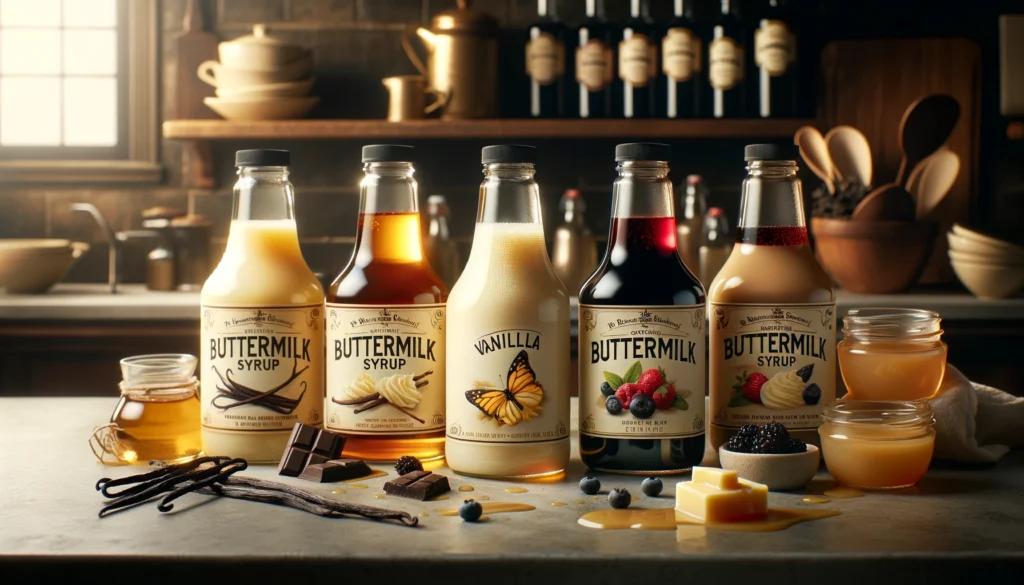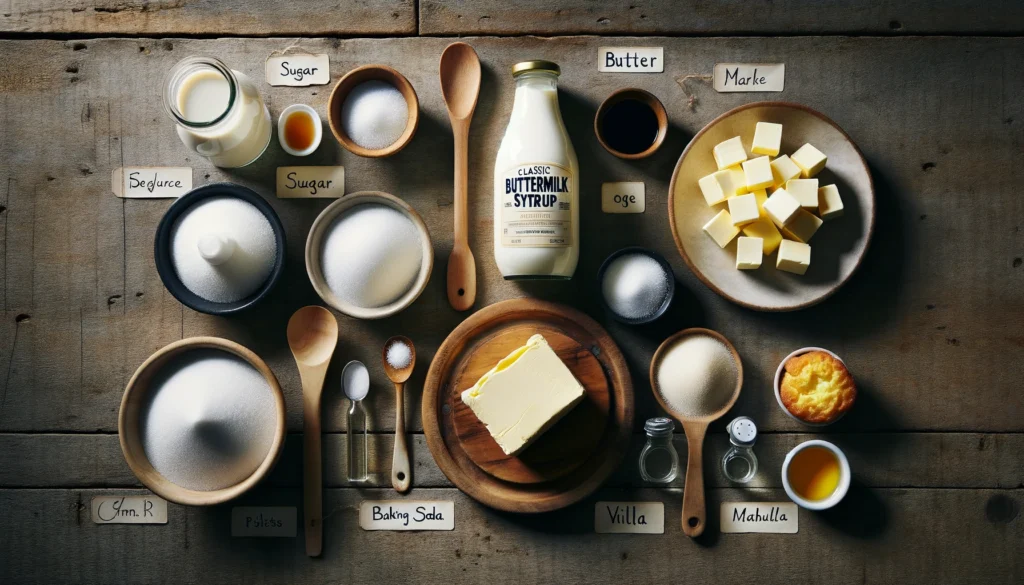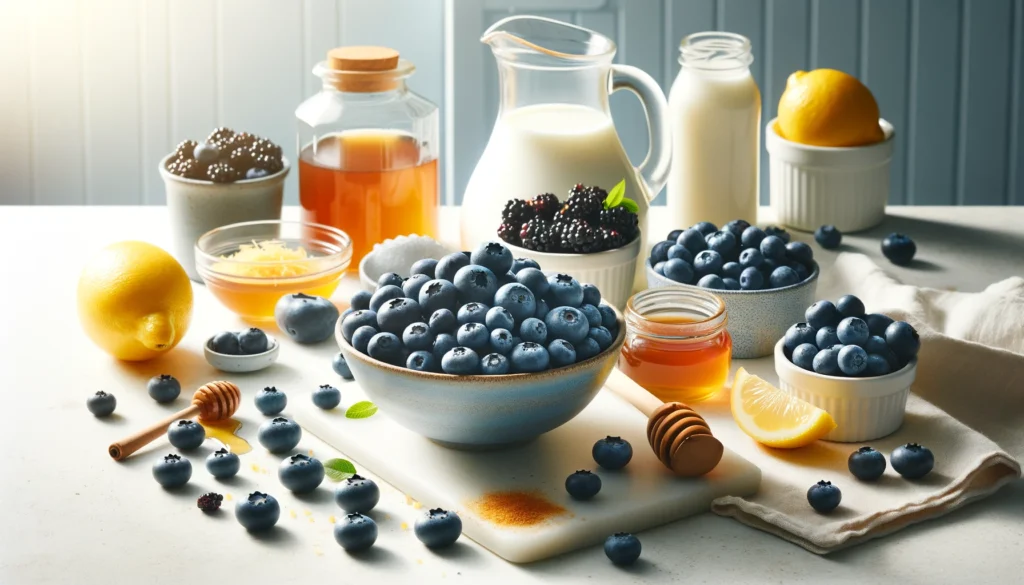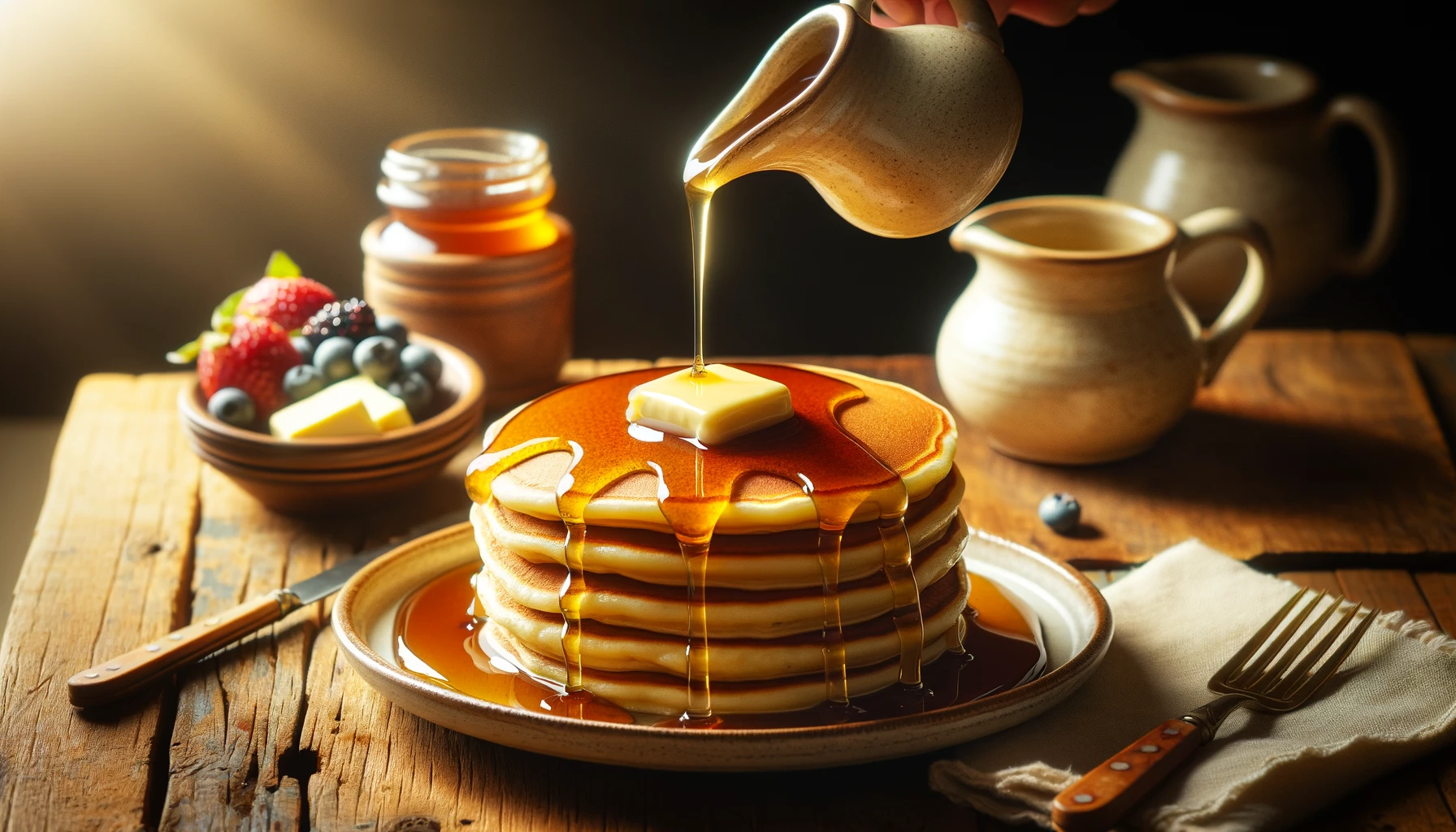buttermilk syrup : A delightful alternative to the classic maple syrup that has been gaining popularity recently is a tangy, creamy concoction enhanced by the sweetness of sugar. This unique combination adds a delightful dimension to pancakes, waffles, and other breakfast dishes.
This detailed guide covers all you need to know about this unique syrup. We’ll explore its origins, dive into the secrets behind its distinctive taste, introduce various recipes to match your palate, and reveal surprising methods to use it beyond the morning meal.
A Tangy Twist: The History of Buttermilk Syrup
The exact origins of buttermilk syrup remain a bit hazy, but its roots likely lie in the American South. Traditionally, buttermilk, a leftover from butter churning, was a readily available ingredient in many households. While exact dates are unclear, historical references suggest the use of buttermilk in syrups and sweet sauces emerged sometime in the late 19th or early 20th century.
- “If you’re looking for a savory dish to balance out your sweet treats, mastering the art of chicken cobbler can bring comfort in every layer.”
- Link: Mastering Chicken Cobbler
Evolution of Buttermilk Syrup
Initially, traditional syrup recipes were likely passed down through families and communities, with variations emerging based on regional preferences. Sugar was the most common sweetener, but some recipes might have incorporated honey or molasses. As commercial production of these syrups increased in the mid-20th century, standardized recipes became more widespread.
A Modern-Day Favorite
Today, buttermilk syrup enjoys a resurgence in popularity, particularly among those seeking unique and flavorful breakfast options. Its versatility extends beyond the breakfast table, with chefs experimenting with its use in glazes, marinades, and even cocktails.
Unveiling the Flavor: What Makes Buttermilk Syrup Special?
Buttermilk syrup’s unique flavor profile is its defining characteristic. Here’s what sets it apart:
- Tangy Creaminess: Buttermilk, a fermented dairy product, adds a subtle tang that cuts through the sweetness of the sugar. This creates a more complex flavor profile compared to traditional maple syrup.
- Rich Depth: The fermentation process in buttermilk also contributes a subtle depth of flavor, adding an intriguing layer to the overall taste.
- Balanced Sweetness: The tanginess of buttermilk helps to balance the sweetness of the syrup, making it a good option for those who prefer a less sugary breakfast topping.
Beyond the Basics: Different Types of Buttermilk Syrup

Classic Buttermilk Syrup
This traditional recipe combines buttermilk, sugar, and butter for a simple yet flavorful syrup. The ratio of sugar to buttermilk can vary depending on personal preference, allowing for adjustments to achieve your desired level of sweetness.
Spiced Buttermilk Syrup
Adding a touch of warmth, spices like cinnamon, nutmeg, or cloves can elevate the flavor profile of buttermilk syrup. This variation pairs perfectly with fall-inspired dishes like pumpkin pancakes or apple waffles.
Fruity Buttermilk Syrup
For a burst of fruity flavor, consider incorporating fresh or frozen berries like blueberries, raspberries, or strawberries into the syrup during the cooking process. This option complements dishes like ricotta pancakes or French toast.
Herb-Infused Buttermilk Syrup
For a savory twist, explore the realm of herb-infused buttermilk syrup. Fresh herbs like thyme or rosemary can be steeped in the syrup while it cooks, imparting a subtle herbal note that pairs surprisingly well with savory breakfast dishes or even grilled chicken.
DIY Delight: Easy Homemade Buttermilk Syrup Recipes
The beauty of tangy syrup lies in its simplicity of preparation. Here are a few recipes to get you started:
Classic Recipe
This recipe perfect for those who want to explore the original flavor.
Ingredients:

- 1 cup granulated sugar
- 1/2 cup buttermilk
- 1/2 cup butter, unsalted
- 1 teaspoon vanilla extract (optional)
Instructions:
- In a saucepan over medium heat, combine sugar and buttermilk. Whisk constantly until the sugar dissolves.
- Bring the mixture to a boil, then reduce heat and simmer for 3-4 minutes, stirring occasionally, until the syrup thickens slightly.
3. Remove from heat and stir in butter until melted. Be careful not to overcook the syrup, as it will continue to thicken slightly as it cools. 4. Allow the syrup to cool slightly before adding vanilla extract (optional). Strain the syrup, if desired, to remove any butter solids. 5. Store in an airtight container in the refrigerator for up to two weeks.
Spiced Recipe
This recipe adds a touch of warmth with the inclusion of cinnamon and nutmeg.
Ingredients:

- 1 cup granulated sugar
- 1/2 cup buttermilk
- 1/2 cup butter, unsalted
- 1 teaspoon ground cinnamon
- 1/4 teaspoon ground nutmeg
- 1 teaspoon vanilla extract (optional)
Instructions:
- Follow steps 1-3 from the Classic Buttermilk Syrup recipe, adding cinnamon and nutmeg along with the sugar and buttermilk.
- Continue with steps 4 and 5 from the Classic Buttermilk Syrup recipe.
Fruity Recipe (Blueberry Option)

This recipe incorporates fresh blueberries for a burst of fruity flavor. You can substitute other berries like raspberries or strawberries if desired.
Ingredients:
- 1 cup granulated sugar
- 1/2 cup buttermilk
- 1/2 cup butter, unsalted
- 1 cup fresh blueberries
- 1 teaspoon lemon juice (optional)
- 1 teaspoon vanilla extract (optional)
Instructions:
- In a saucepan over medium heat, combine sugar and buttermilk. Whisk constantly until the sugar dissolves.
- Add blueberries and simmer for 5-7 minutes, stirring occasionally, until the berries soften and release their juices.
- Strain the mixture through a fine-mesh sieve to remove the blueberry skins and seeds. Return the strained syrup to the saucepan.
- Bring the syrup to a boil, then reduce heat and simmer for 3-4 minutes, stirring occasionally, until the syrup thickens slightly.
- Remove from heat and stir in butter until melted. Add lemon juice (optional) and vanilla extract (optional).
- Allow the syrup to cool slightly before straining again (optional) to remove any remaining blueberry pulp.
- Store in an airtight container in the refrigerator for up to two weeks.
Beyond Breakfast: Exploring Unexpected Uses
Buttermilk syrup’s versatility extends far beyond the breakfast table. Here are some creative ways to utilize this flavorful topping:
- “Enhance your culinary experience by discovering the irresistible charm of chicken pot pie, a perfect savory Link: Chicken Pot Pie Charm
Savory Applications
- Glaze: Brush buttermilk syrup on chicken or pork during grilling for a sweet and tangy glaze.
- Marinade: Combine buttermilk syrup with soy sauce, Dijon mustard, and ginger for a unique marinade for grilled chicken or tofu.
- Salad Dressing: Whisk together buttermilk syrup with olive oil, vinegar, and your favorite herbs for a delicious salad dressing.
Baking and Desserts
- Pie Filling: Drizzle buttermilk syrup over fresh fruit before baking in a pie crust for a delicious and tangy twist.
- Cake Glaze: Drizzle warm buttermilk syrup over a freshly baked cake for a flavorful glaze.
- Ice Cream Topping: Spoon buttermilk syrup over vanilla ice cream for a delightful sundae topping.
- “For those who love to complement their desserts with something sweet and rich, exploring homemade fudge can be a delightful journey.” Homemade Fudge Mastery
Drinks
- Cocktail Mixer: Add a splash of buttermilk syrup to your favorite bourbon cocktail for a touch of sweetness and complexity.
- Mocktail Flavoring: Use buttermilk syrup to add a unique flavor profile to homemade mocktails or non-alcoholic beverages.
Conclusion: A Tangy Twist on Tradition
Buttermilk syrup offers a delightful departure from traditional maple syrup. Its unique flavor profile, combining tangy buttermilk with sweetness, adds a delightful dimension to breakfast dishes. Beyond breakfast, buttermilk syrup’s versatility shines through in its potential for savory and sweet applications. Whether you choose to create your own homemade syrup with various flavor variations or explore store-bought options, buttermilk syrup promises to elevate your culinary creations.
Frequently Asked Questions
What is buttermilk syrup made of?
Buttermilk syrup offers a delightful twist on classic maple syrup. Its core ingredients typically include:
- Sugar: Granulated sugar is the most common sweetener, but additionally, some recipes might incorporate brown sugar, honey, or molasses for a richer flavor profile.
- Buttermilk: This fermented milk product adds a signature tangy creaminess that balances the sweetness of the sugar.
- Butter: Unsalted butter is often included for richness and a smooth texture. However, some recipes might omit butter for a lighter option.
- Flavorings (Optional): Spices like cinnamon, nutmeg, or cloves can be added for warmth. In addition, fresh or frozen berries, herbs like thyme or rosemary, or even vanilla extract can be incorporated depending on your desired flavor variation.
How can I make buttermilk?
While buttermilk is traditionally a leftover from butter churning, you can easily create a buttermilk substitute at home:
- Combine 1 cup of milk with 1 tablespoon of lemon juice or vinegar.
- Let the mixture sit for 5-10 minutes, allowing the milk to curdle slightly. This mimics the acidity of buttermilk.
How many calories are in buttermilk syrup?
The exact calorie content can vary depending on the recipe and ingredients used.
. However, a typical serving (around 2 tablespoons) can range from 50-70 calories. Here’s a breakdown of the main contributors:
- Sugar: The primary source of calories in buttermilk syrup.
- Buttermilk: Contains minimal calories but contributes some protein.
- Butter: Adds richness and calories due to its fat content. (May be omitted in some recipes)
Can you save buttermilk syrup?
Yes, you can definitely save
- Store homemade buttermilk syrup in an airtight container in the refrigerator for up to two weeks.
conclusion
This syrup provides a delightful alternative to traditional maple syrup, blending a tangy taste with sweetness to add a unique dimension to breakfast dishes. Its versatility extends beyond morning meals, shining in both savory and sweet dishes. Whether you opt for homemade versions with diverse flavors or explore store-bought varieties, this syrup is sure to elevate your culinary creations.
For an in-depth exploration of the history and science of fermentation, a process that plays a key role in buttermilk syrup’s unique flavor, check out this informative article:
Link Source:
- Website: Scientific American (https://www.scientificamerican.com/)

